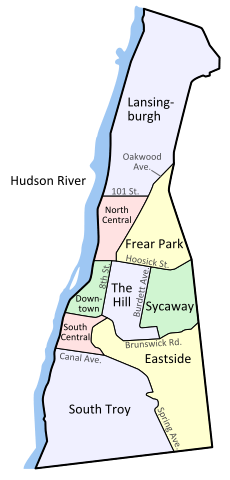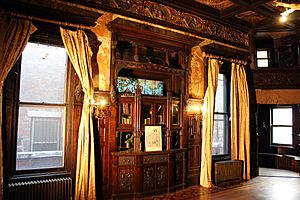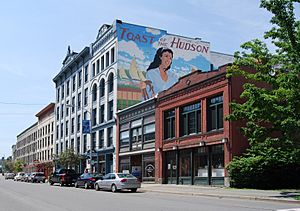Troy, New York facts for kids
Quick facts for kids
Troy
|
||
|---|---|---|
|
From top, left to right: View of Troy from the Rensselaer Polytechnic Institute campus; Rice Building; Monument Square and the Soldiers and Sailors Monument; A CDTA bus stop on Congress Street; Skyline of Troy
|
||
|
||
| Etymology: Classical Troy | ||
| Nickname(s):
The Collar City
|
||
| Motto(s):
Ilium fuit, Troja est (Latin for "Ilium was, Troy is" also translates as "Troy was, Troy is")
|
||

Map of Troy and its major thoroughfares
|
||

Location of New York in the United States
|
||
| Country | ||
| State | ||
| County | Rensselaer | |
| Settled | 1787 | |
| Named for | Ancient Troy | |
| Government | ||
| • Type | Troy City Hall | |
| • Body | Troy City Council | |
| Area | ||
| • City | 11.06 sq mi (28.64 km2) | |
| • Land | 10.36 sq mi (26.83 km2) | |
| • Water | 0.70 sq mi (1.81 km2) | |
| Highest elevation | 500 ft (200 m) | |
| Lowest elevation | 0 ft (0 m) | |
| Population
(2020)
|
||
| • City | 51,401 | |
| • Density | 4,962.92/sq mi (1,916.11/km2) | |
| • Metro | 1,170,483 | |
| Demonym(s) | Trojan | |
| Time zone | UTC−5 (Eastern (EST)) | |
| • Summer (DST) | UTC−4 (EDT) | |
| ZIP Codes |
12179–12182
|
|
| Area code(s) | 518 | |
| FIPS code | 36-083-75484 | |
| FIPS code | 36-75484 | |
| GNIS feature ID | 0967902 | |
| Wikimedia Commons | Troy, New York | |
| Website | www.troyny.gov | |
Troy is a city in New York, located in Rensselaer County. It sits on the eastern bank of the Hudson River, just north of Albany, the state capital. Troy is part of a larger area known as the Capital District, which also includes Albany and Schenectady.
Troy is one of the main cities in the Albany metropolitan area, which has over 1.1 million people. In 2020, about 51,401 people lived in Troy.
Long ago, the Mohican Native American tribe lived here. Dutch settlers arrived in the mid-1600s. The English took over the area in 1664. The city was named Troy in 1789 and became a town in 1791. Because of its location near major rivers and water power, Troy became a key place during the American Industrial Revolution. Around the early 1900s, it was one of the wealthiest cities in America. This history means Troy has many beautiful old buildings with Victorian architecture.
Troy is also home to several colleges. These include Rensselaer Polytechnic Institute, Hudson Valley Community College, and Russell Sage College.
Contents
Discovering Troy's Past
Early Days: Native Americans and European Settlers
Before Europeans arrived, the Mohican people lived along the Hudson River. They had several villages near where the Hudson and Mohawk Rivers meet. Different Mohican groups owned the land around the Poesten Kill and Wynants Kill, which are Dutch words for "creek."
Between 1630 and 1657, the Mohican people sold these lands to the Dutch. Many Mohican individuals, including their leader, Skiwias, were part of these land sales.
From Dutch Farms to a Growing City
The area where Troy now stands was once part of a large Dutch land grant called Rensselaerswyck. Dirck Van der Heyden was one of the first settlers. In 1707, he bought a 65-acre farm. This farm later became the layout for the village in 1787.
The name Troy was chosen in 1789. It was named after the famous ancient Greek city of Troy from Homer's Iliad. Before this, the small community was called Ashley's Ferry. Troy became a town in 1791 and then a city in 1816. Many towns in New York were given classical names during this time. Troy's Latin motto, Ilium fuit, Troja est, means "Ilium was, Troy is."
Troy's Role in American History
During the War of 1812, Troy was important for shipping supplies. A local butcher, Samuel Wilson, supplied meat to the military. He stamped the barrels "U.S." People started saying "U.S." stood for "Uncle Sam," meaning Wilson. Because of this, Troy claims to be the home of Uncle Sam. Samuel Wilson is buried in Oakwood Cemetery in Troy.
In 1823, The Troy Sentinel newspaper first published the famous Christmas poem "A Visit from St. Nicholas" (also known as "The Night Before Christmas").
Troy is also known for its strong focus on science and technology. Rensselaer Polytechnic Institute (RPI) was founded here in 1824. It was started by Stephen Van Rensselaer III to apply science to everyday life. RPI is the oldest technological university in the English-speaking world. It is famous for turning lab discoveries into real-world products.
Troy's Industrial Power and Challenges
In the 1800s and early 1900s, Troy was a very successful city. It was a major shipping point for goods from Vermont and New York, sent down the Hudson River to New York City. This trade grew even more after the Erie Canal opened in 1825. The canal's eastern end was just across the Hudson River from Troy.
Troy was almost completely destroyed by large fires three times. The Great Troy Fire of 1862 caused a lot of damage.
Troy became wealthy from its steel industry. The first American Bessemer converter, a machine for making steel, was built here. Iron and steel from Troy were also used at the federal arsenal across the Hudson River in Watervliet. After the Civil War, steel production moved west. However, Troy's history with iron and steel led to early uses of iron storefronts and steel supports in buildings. Some of these unique buildings still stand today.
Sports History in Troy
Troy was an early home for professional baseball. The Troy Haymakers played here in 1871–72. Later, the National League's Troy Trojans played from 1879 to 1882.
Today, the Tri-City ValleyCats, a minor league baseball team, play at Joseph L. Bruno Stadium. The RPI Engineers have successful sports teams, especially in ice hockey, where they have won national championships. Hudson Valley Community College and Russell Sage College also have active sports programs.
Troy Today: Looking to the Future
Like many old industrial cities, Troy has faced challenges as manufacturing jobs moved away. This led to some areas falling into disrepair. However, people are now working hard to preserve Troy's historic buildings and culture.
The city is updating its plans for the future. This project, called "Realize Troy," aims to redevelop the city.
Exploring Troy's Landscape
Troy covers about 11 square miles. About 0.6 square miles of this area is water.
The city is located north of Albany, where the Erie and Champlain canals meet the Hudson River. It is a key distribution center for the region.
Troy is on the western edge of Rensselaer County. The Hudson River forms its western border with Albany County. The city also borders other towns and villages.
The western part of Troy along the river is flat. Then, the land rises steeply to higher areas in the east. The average height above sea level is 50 feet, with the highest point being 500 feet. Several small creeks, called "kills" (from Dutch), flow through Troy and into the Hudson River. The Poesten Kill and Wynants Kill are the largest, with small lakes and waterfalls. Troy also has several lakes and reservoirs, like Ida Lake and Burden Pond.
Troy's Weather
Troy has a humid continental climate. This means it has warm summers and cold winters. The average temperature for the year is about 50.9°F (10.5°C). July is the warmest month, averaging 74.9°F (23.8°C), and January is the coldest, averaging 25.5°F (-3.6°C). The city gets about 42 inches of rain each year.
The highest temperature ever recorded in New York State was in Troy on July 22, 1926, when it reached 108°F (42.2°C).
| Climate data for Troy, New York (1991–2020 normals, extremes 1932–2018) | |||||||||||||
|---|---|---|---|---|---|---|---|---|---|---|---|---|---|
| Month | Jan | Feb | Mar | Apr | May | Jun | Jul | Aug | Sep | Oct | Nov | Dec | Year |
| Record high °F (°C) | 66 (19) |
75 (24) |
86 (30) |
92 (33) |
97 (36) |
96 (36) |
108 (42) |
99 (37) |
96 (36) |
89 (32) |
83 (28) |
72 (22) |
101 (38) |
| Mean maximum °F (°C) | 55.6 (13.1) |
54.8 (12.7) |
65.4 (18.6) |
82.9 (28.3) |
88.4 (31.3) |
92.5 (33.6) |
93.0 (33.9) |
92.6 (33.7) |
89.2 (31.8) |
79.0 (26.1) |
69.7 (20.9) |
57.6 (14.2) |
95.4 (35.2) |
| Mean daily maximum °F (°C) | 34.2 (1.2) |
37.1 (2.8) |
46.0 (7.8) |
60.2 (15.7) |
72.5 (22.5) |
80.5 (26.9) |
85.6 (29.8) |
84.1 (28.9) |
77.2 (25.1) |
63.7 (17.6) |
51.0 (10.6) |
39.7 (4.3) |
61.0 (16.1) |
| Daily mean °F (°C) | 25.5 (−3.6) |
27.7 (−2.4) |
36.1 (2.3) |
48.9 (9.4) |
60.9 (16.1) |
69.7 (20.9) |
74.9 (23.8) |
73.1 (22.8) |
65.8 (18.8) |
53.4 (11.9) |
42.1 (5.6) |
32.2 (0.1) |
50.9 (10.5) |
| Mean daily minimum °F (°C) | 16.9 (−8.4) |
18.2 (−7.7) |
26.2 (−3.2) |
37.7 (3.2) |
49.3 (9.6) |
59.0 (15.0) |
64.1 (17.8) |
62.2 (16.8) |
54.4 (12.4) |
43.2 (6.2) |
33.2 (0.7) |
24.7 (−4.1) |
40.8 (4.9) |
| Mean minimum °F (°C) | −4.8 (−20.4) |
−1.4 (−18.6) |
8.0 (−13.3) |
25.4 (−3.7) |
34.9 (1.6) |
46.2 (7.9) |
53.3 (11.8) |
50.1 (10.1) |
40.2 (4.6) |
29.4 (−1.4) |
19.2 (−7.1) |
6.7 (−14.1) |
−7.5 (−21.9) |
| Record low °F (°C) | −23 (−31) |
−17 (−27) |
−11 (−24) |
13 (−11) |
20 (−7) |
38 (3) |
45 (7) |
35 (2) |
29 (−2) |
20 (−7) |
10 (−12) |
−15 (−26) |
−23 (−31) |
| Average precipitation inches (mm) | 2.65 (67) |
2.43 (62) |
2.91 (74) |
3.09 (78) |
3.79 (96) |
4.61 (117) |
4.64 (118) |
3.92 (100) |
3.83 (97) |
4.23 (107) |
2.84 (72) |
3.15 (80) |
42.09 (1,069) |
| Average precipitation days (≥ 0.01 in) | 10.1 | 8.1 | 9.2 | 11.3 | 12.1 | 11.4 | 11.4 | 10.1 | 9.5 | 11.9 | 10.2 | 10.3 | 125.6 |
| Source: NOAA | |||||||||||||
People of Troy
| Historical population | |||
|---|---|---|---|
| Census | Pop. | %± | |
| 1820 | 5,264 | — | |
| 1830 | 11,556 | 119.5% | |
| 1840 | 19,334 | 67.3% | |
| 1850 | 28,785 | 48.9% | |
| 1860 | 39,235 | 36.3% | |
| 1870 | 46,465 | 18.4% | |
| 1880 | 56,747 | 22.1% | |
| 1890 | 60,956 | 7.4% | |
| 1900 | 60,651 | −0.5% | |
| 1910 | 76,813 | 26.6% | |
| 1920 | 71,996 | −6.3% | |
| 1930 | 72,763 | 1.1% | |
| 1940 | 70,304 | −3.4% | |
| 1950 | 72,311 | 2.9% | |
| 1960 | 67,492 | −6.7% | |
| 1970 | 62,918 | −6.8% | |
| 1980 | 56,638 | −10.0% | |
| 1990 | 54,269 | −4.2% | |
| 2000 | 49,170 | −9.4% | |
| 2010 | 50,129 | 2.0% | |
| 2020 | 51,401 | 2.5% | |
| U.S. Decennial Census 2020 | |||
In 2010, Troy had 50,129 people living in 20,121 households. The population density was about 4,840 people per square mile. Most residents (69.7%) were White, 16.4% were African American, and 7.9% were Hispanic or Latino.
The average household income in 2013 was $37,805. About 27.3% of the people lived in poverty.
By 2020, Troy's population grew to 51,401. The number of African American residents increased to 17.5%, while White residents made up 63.5%. The population is slightly more women (51.4%) than men (48.6%).
About 19.6% of Troy's residents are under 18, and 11.4% are 65 or older. In 2020, the average household income was $45,728. The poverty rate had dropped to 24.4%.
Many Troy residents are well-educated. About 86.8% of people 25 or older have a high school diploma or higher. Also, 26.8% have a bachelor's degree or higher. Most households (88.5%) have a computer, and 81.5% have internet access.
Troy is home to many different places of worship. These include churches, synagogues, and a mosque.
Troy's Economy and Industries
Troy is known as the "Collar City." This nickname comes from its history of making shirts, collars, and other textiles. Until the early 1990s, Troy had several textile factories.
The idea for the detachable collar started in Troy in 1820. Mrs. Montague, a local woman, cut collars off her husband's shirts so he could have clean ones easily. This led to a big industry for detachable collars and shirts in Troy. It also created a need for buttons to hold the collars in place. Other clothing items like Bishop collars and separate cuffs were also invented here.
This industry also led to the first laundry businesses. The first laundry store, Troy Laundry, opened in Troy. Later, the laundry industry here helped create the first female labor union in the country. For almost 100 years, Cluett, Peabody & Company was the biggest company in Troy. They made detachable collars, "Arrow shirts," and other clothing. Around the early 1900s, Troy made 90% of all collars worn in America!
This industry also gave us the terms "white collar" for office workers and "blue collar" for factory workers. By the 1960s, most of this industry had moved away or closed down.
At one time, Troy was also the second-largest producer of iron in the United States, only behind Pittsburgh, Pennsylvania.
Today, Troy is working to grow new industries. The presence of RPI helps Troy develop a small high-tech sector, especially in video game development. Downtown Troy also has advertising, architecture, and other creative businesses. These companies are drawn to the area's unique historic buildings. RPI is the city's largest private employer.
Arts, Culture, and Landmarks
Troy's Unique Architecture
Troy is famous for its beautiful buildings from the Victorian and Belle Époque periods. The city's location near the Hudson and Mohawk Rivers, and the Erie Canal, helped it grow. Later, railroads connected Troy to other major cities.
People in Troy loved to build with strong materials. They used:
- Iron: For decorative fronts of buildings, gates, railings, and stairwells.
- Stone: For strong foundations, building fronts, and fancy decorations.
- Glass: Many buildings have amazing stained-glass windows and designs.
- Wood: You can find beautiful wood details inside many of Troy's buildings.
Artists like Tiffany and La Farge created stunning stained-glass windows for Troy's buildings. Because so many 19th-century buildings are still standing, especially in the downtown area, Troy has been a filming location for several movies. These include Ironweed, The Age of Innocence, and Scent of a Woman. The TV series The Gilded Age also filmed scenes in Troy. While some buildings need repair, community groups are working to restore them.
Some important historic buildings downtown include:
- The Frear's Troy Cash Bazaar, made with steel and white marble.
- The Corinthian Courthouse, built from gray granite.
- The Troy Public Library, designed like an Italian palace with carved white marble.
- The Troy Savings Bank Music Hall, known for its excellent sound.
Many old homes around downtown show different architectural styles. These include Colonial, Federal, Italianate, Second Empire, Greek Revival, and Gothic Revival styles.
In the 1970s, some city blocks were torn down for a redevelopment plan that didn't happen. This left empty spaces. But now, there are successful efforts to save the remaining historic buildings.
Part of this effort is the "Antique District" on River Street downtown. You can find cafes and art galleries there. Visitors can also use the Troy Downtown Marina. Troy loves art, literature, and music, hosting many free shows in the summer.
Fun Events in Troy
Troy hosts many exciting events throughout the year:
- Troy River Fest – An arts, crafts, and music festival every June.
- The Victorian Stroll – Held every December, celebrating the city's Victorian past.
- Troy Turkey Trot – A Thanksgiving Day race, the oldest in the Capital District.
- The Enchanted City – A Steampunk festival downtown.
- Troy Night Out – A monthly event celebrating arts and culture downtown.
- Rockin' on the River – An outdoor concert series from June to August.
- Troy Pig Out – A BBQ competition in Riverfront Park.
- Chowderfest – A festival celebrating chowder downtown.
- Troy Waterfront Farmers Market – Held weekly, outdoors in summer and indoors in winter.
Learning in Troy
Troy is home to many schools and colleges. Rensselaer Polytechnic Institute (RPI) was founded in 1824. In 1821, Emma Willard started the Troy Female Seminary, which later became the Emma Willard School. This was America's first high school for girls. The former seminary later reopened as Russell Sage College in 1916. All these schools are still active today.
Troy also has Hudson Valley Community College, which is part of the State University of New York system and has 10,000 students. There are two public school districts: Troy and Lansingburgh. Three private high schools are also in Troy: La Salle Institute, Emma Willard School, and Catholic Central High School. Troy Prep is a K-12 charter school system.
Getting Around Troy
Transportation Options
Buses
The Capital District Transportation Authority (CDTA) runs regional and local buses. CDTA's Blue, Red, and Purple Lines offer Bus Rapid Transit in Troy. These connect the city to Albany, Cohoes, Waterford, and Watervliet.
Roads
Several main roads pass through Troy. US 4 runs north-south along River Street and 3rd & 4th Streets. New York State Route 7 goes east-west on Hoosick Street, crossing the Hudson River on the Collar City Bridge. New York State Route 2 also goes east-west on Congress Street, using the Congress Street Bridge to cross the Hudson.
Trains
In the past, several railroad companies provided passenger train service to Troy. However, by the late 1950s, passenger service ended. Troy Union Station closed and was torn down in 1958. Today, Amtrak serves the Albany-Rensselaer station, which is about 8.5 miles south of Troy.
Fire Department
The Troy Fire Department has 119 firefighters. They work from six fire stations across the city. They operate five engine companies, a rescue-engine, two truck companies, three ambulances, a Hazardous Material response unit, and two rescue boats. The Troy Fire Department is responsible for hazardous material responses for all of Rensselaer County.
Famous People from Troy
Troy has been home to many notable individuals:
- Joe Alaskey (1952–2016), a voice actor known for Looney Tunes characters.
- Dave Anderson (1929–2018), a Pulitzer Prize-winning sportswriter.
- Garnet Douglass Baltimore (1859–1946), a civil engineer and the first African-American graduate of RPI.
- Dorothy Lavinia Brown (1919–2004), an African American surgeon and legislator, who grew up in Troy.
- Henry Burden (1791–1871), an engineer who built the Burden Iron Works in Troy.
- James Connolly (1868–1916), a leader of the Irish Easter Rising, lived in Troy for several years.
- Charles Crocker, a railroad executive who helped found the Central Pacific Railroad.
- Courken George Deukmejian Jr. (1928–2018), who became the 35th Governor of California.
- John Joseph Evers (1883–1947), a baseball Hall of Fame player.
- Robert Fuller (born 1933), an actor known for the TV series Wagon Train.
- Alice Fulton (born 1952), a poet and author who grew up in Troy.
- Henry Highland Garnet (1815–1882), an important African-American abolitionist and minister.
- Tim Hauser (1941–2014), a singer and founding member of The Manhattan Transfer.
- Theodore Judah, a railroad engineer for the Central Pacific Railroad.
- King Kelly (1857–1894), a professional baseball player.
- William L. Marcy (1786–1857), a former governor, U.S. senator, and U.S. Secretary of State.
- Herman Melville (1819–1891), the author of Moby Dick, lived nearby.
- John Morrissey (1831–1878), a bare-knuckle boxer and U.S. representative.
- Kate Mullany (1845–1906), an Irish-born labor organizer who founded the Collar Laundry Union.
- Edward Murphy Jr. (1836–1911), a former mayor and U.S. senator.
- Horatio Spafford (1828–1888), who wrote the hymn "It Is Well With My Soul".
- Maureen Stapleton (1925–2006), an Academy Award-winning actress.
- Samuel Wilson (1766–1854), a butcher believed to be the inspiration for Uncle Sam.
Images for kids
See also
 In Spanish: Troy (Nueva York) para niños
In Spanish: Troy (Nueva York) para niños


















